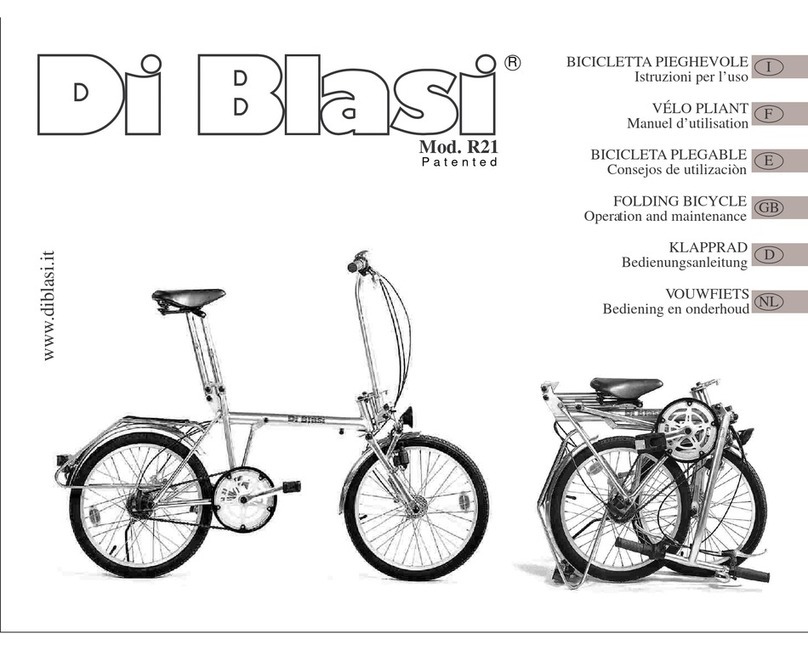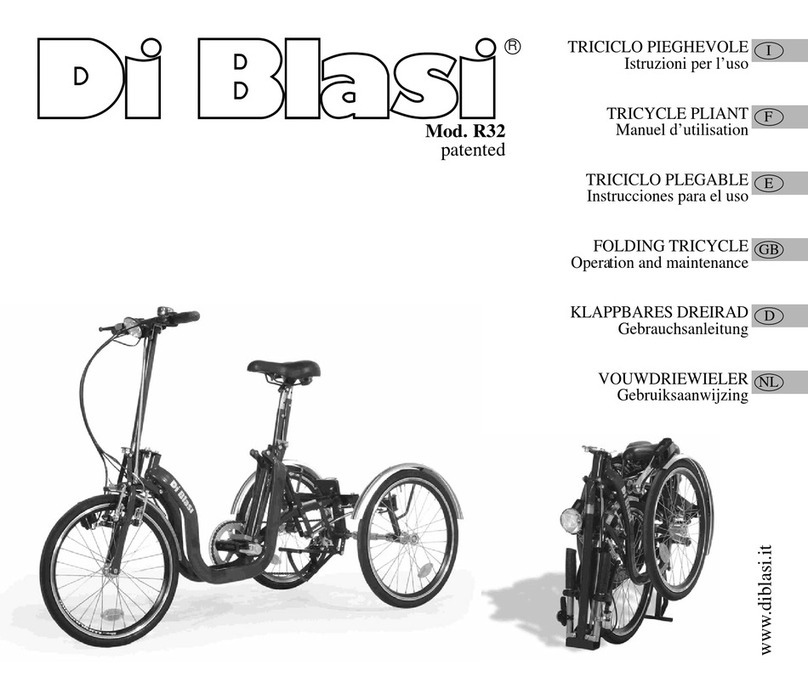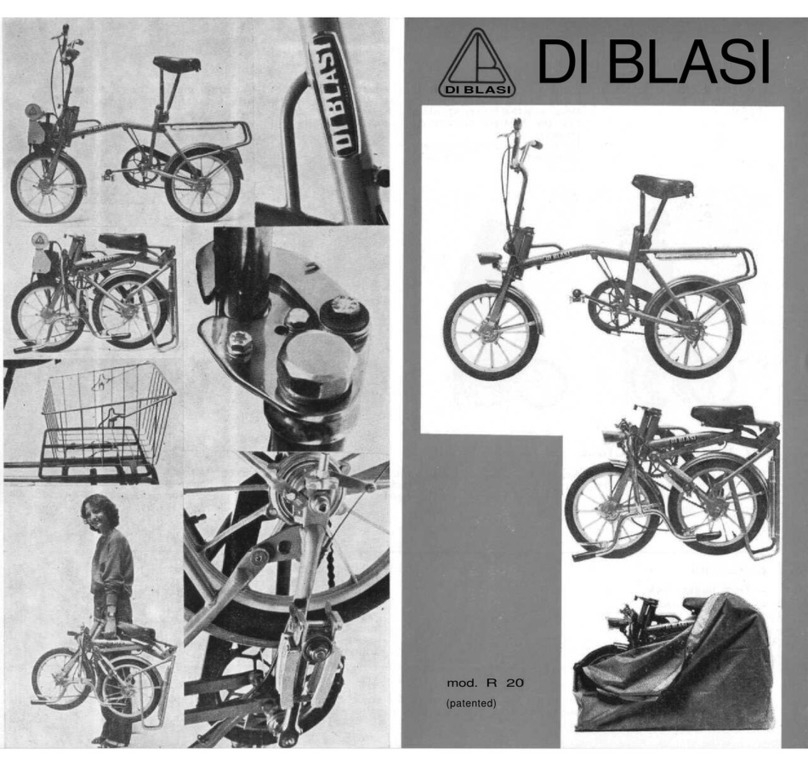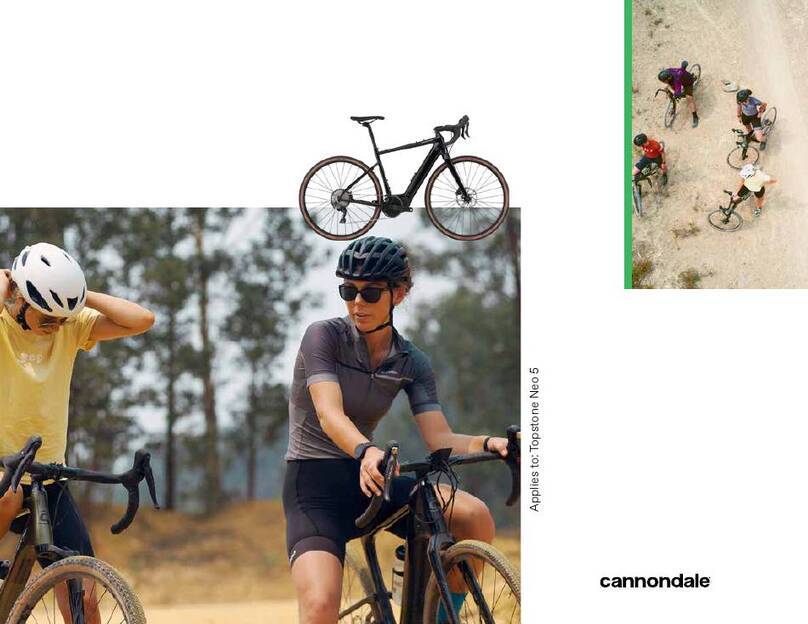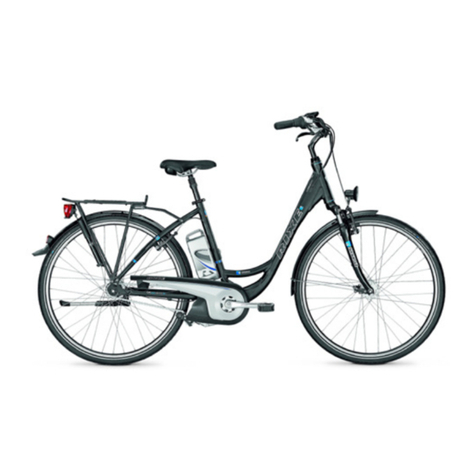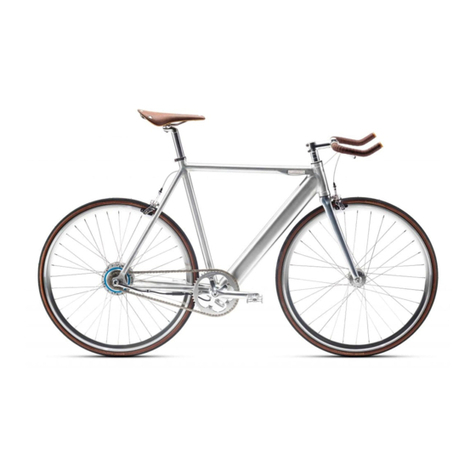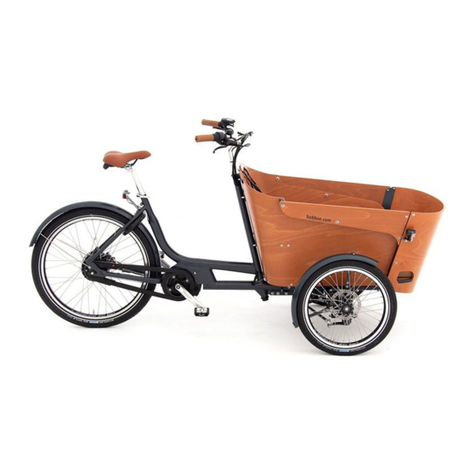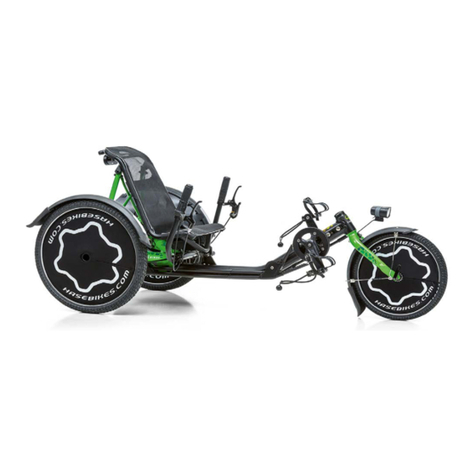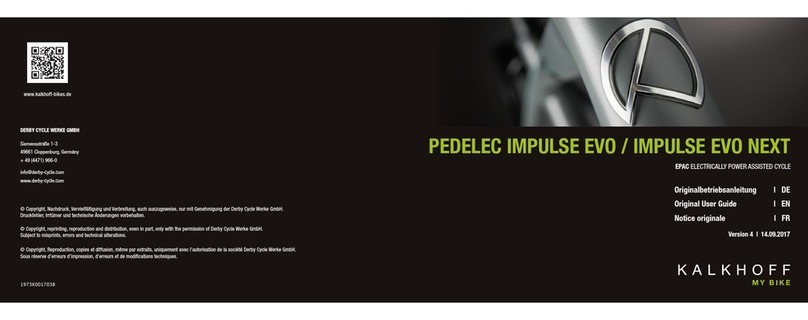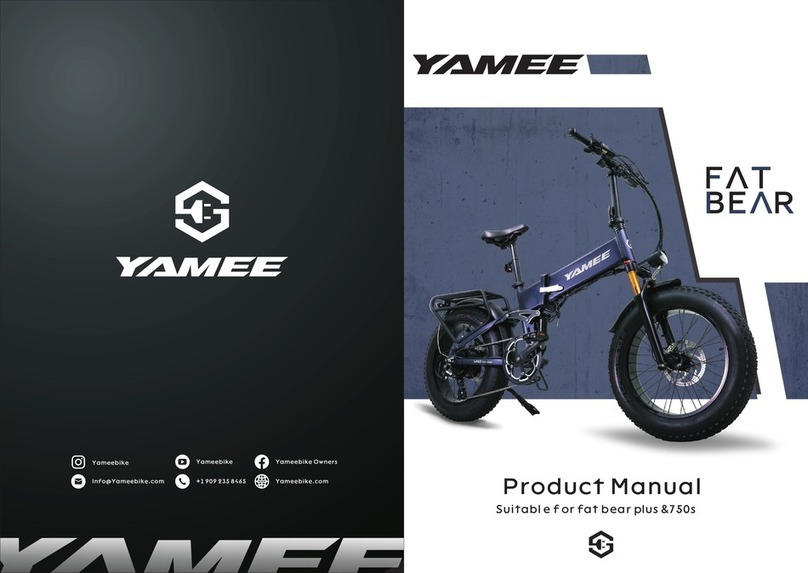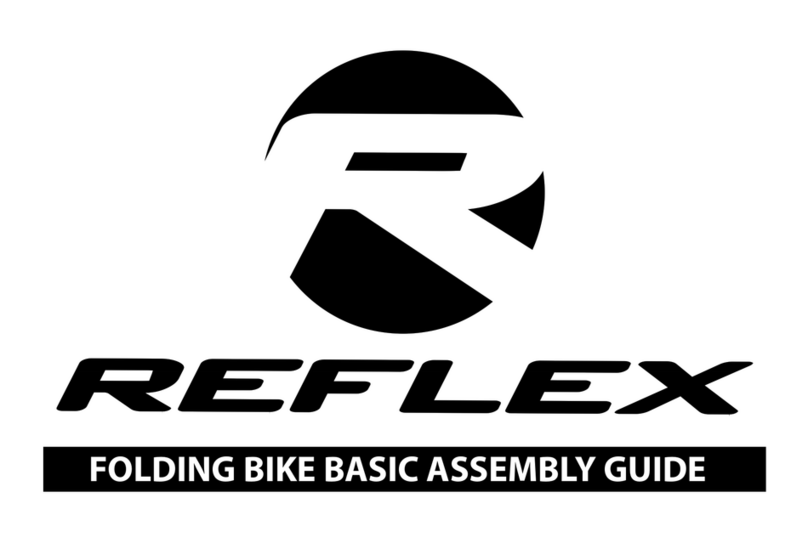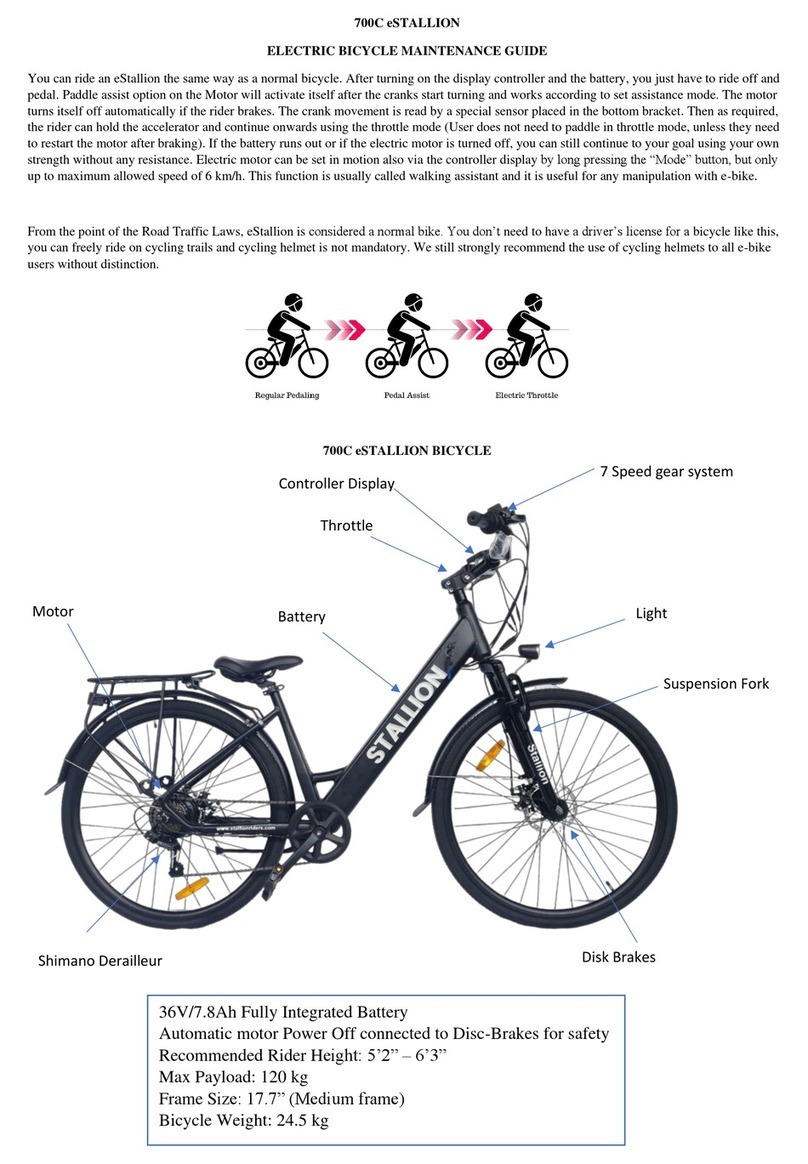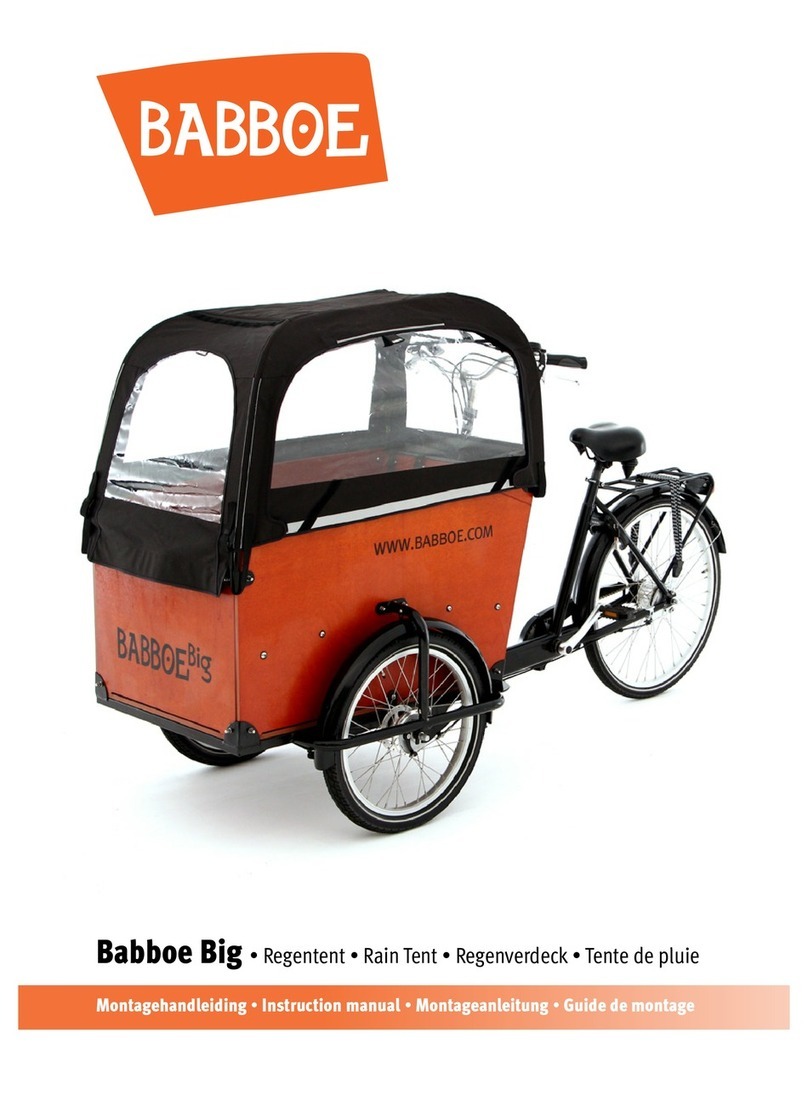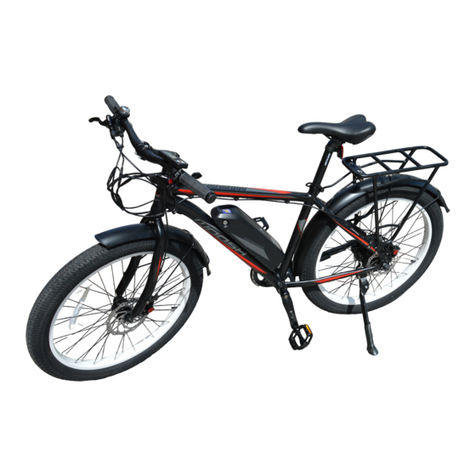DI BLASI R24P Installation guide

GB
D
NL
I
F
E
R
Mod. R24
patented
www.diblasi.it
BICICLETTA PIEGHEVOLE
Istruzioni per l’uso
VÉLO PLIANT
Manuel d’utilisation
BICICLETA PLEGABLE
Instrucciones para el uso
FOLDING BICYCLE
Operation and maintenance
KLAPPRAD
Gebrauchsanleitung
VOUWFIETS
Gebruiksaanwijzing

I F E
ADVERTENCIA
Antes de conducir la bicicleta DI BLASI, efectuar
los controles de seguridad escritos en este manual.
La bicicletta DI BLASI no puede ser utilizada
en recorridos de terracería, para carreras, para
transportar mercancía, etc.: éste puede ser
utilizada solo como una bicicleta normal de
paseo.
NORMAS DE PRUDENCIA
Respetar escrupulosamente el código del tránsito
y las normas de prudencia
Reducir la velocidad en las calles en bajada o
con asfalto arruinado.
Evitar maneobras bruscas o azardadas.
Tener cuidado con los vehículos motorizados
Tener presente que en carretera mojada la
distancia de frenada aumenta consideradamente.
No usarlo en la nieve o en el hielo.
Permitir a los niños de ir en la bicicleta sólo si
tienen una edad adecuada y sólo después de que
un adulto ha efectuado los controles necesarios
de seguridad.
Tener presente que la bicicleta fuè construida
para transportar solo una persona.
AVVERTENZA
Prima di condurre questa bicicletta DI BLASI,
effettuare i controlli di sicurezza prescritti in
questo manuale.
Questa bicicletta non può essere utilizzata su
percorsi fuori strada, per corse, per trasporto
merci, ecc..: essa può essere utilizzata solo come
normale bicicletta da passeggio.
NORME DI PRUDENZA
Rispettare scrupolosamente il codice della strada
e le norme di prudenza.
Ridurre la velocità nelle strade in discesa o con
fondo sconnesso.
Evitare manovre brusche o azzardate.
Fare attenzione ai veicoli motorizzati
Tenere presente che su strada bagnata la distanza
di frenata aumenta considerevolmente.
Non andare sulla neve o su ghiaccio.
Permettere ai bambini di andare in bicicletta solo
se hanno un’età adeguata e solo dopo che un
adulto ha effettuato i necessari controlli di
sicurezza.
La bicicletta può portare solo una persona
CONSEILS D’UTILISATION
Avant de conduire cette bicyclette DI BLASI,
effectuez les contrôles de sécurité prescrits dans
ce Manuel d’Utilisation.
Tenez compte que cette bicyclette ne doit pas
être utilisée sur parcours non routiers, ou comme
bicyclette de course, ou pour des transports
lourds: elle peut être utilisée seulement comme
une bicyclette de tourisme normale.
NORMES DE PRUDENCE
Respectez scrupuleusement le code de la route
et les notions de prudence.
Réduisez la vitesse en descente ou si le revêtement
routier n’est pas en bon état.
Evitez les manoeuvres précipitées et brutales.
Faire attention aux véhicules motorisés.
Faire attention que si la chaussée est mouillée
ou polluée les distances de freinage peuvent
augmenter de façon considérable.
Ne roulez pas sur la neige ni sur le verglas.
Permettez aux enfants de utiliser la bicyclette
seulement s’ils ont l’age appropriée et seulement
après que un adulte a effectué les contrôles de
sécurité.
La bicyclette peut transporter seulement une
personne.

GB D NL
HINWEIS
Bevor Sie das DI BLASI Klapprad verwenden,
müssen Sie die in diesem Handbuch
vorgeschriebenen Sicherheitskontrollen
durchführen.
Dieses Klapprad darf nicht für Geländestrecken,
Rennen, Gütertransport usw., sondern nur als
normales Klapprad zum Spazieren fahren
verwendet werden.
VORSICHTSANWEISUNGEN
Die Straßenverkehrordnung und
Vorsichtsanweisungen genauestens einhalten.
Auf Straßen mit Gefällen oder unebenem
Untergrund die Geschwindigkeit reduzieren.
Keine plötzlichen oder riskanten Manöver
ausführen.
Die Fahrzeuge mit Motor beachten.
Beachten Sie, dass auf der nassen Straße der
Bremsweg viel länger ist.
Nicht mit dem Dreirad auf Schnee oder Eis
fahren.
Kinder dürfen das Klapprad nur verwenden,
wenn sie alt genug sind und nachdem ein
Erwachsener die erforderlichen
Sicherheitskontrollen ausgeführt hat.
Das Klapprad kann nur eine Person befördern.
WAARSCHUWING
Voer de veiligheidscontroles die in deze
handleiding staan beschreven uit voordat u met
de DI BLASI vouwfiets gaat rijden.
Deze vouwfiets is niet geschikt voor terreinrijden,
wielrennen, goederentransport, enz.: de vouwfiets
is alleen bedoeld voor gebruik als normale
toerfiets.
VEILIGHEIDSVOORSCHRIFTEN
Houd u aan de verkeersregels en de
veiligheidsvoorschriften.
Verminder uw snelheid op aflopende wegen of
op wegen met een slecht wegdek.
Vermijd plotselinge of gevaarlijke manoeuvres.
Let goed op gemotoriseerde voertuigen.
Denk eraan dat op natte wegen de remweg
aanzienlijk langer is.
Rijd niet op sneeuw of ijs.
Laat kinderen alleen op de vouwfiets rijden als
ze daar de leeftijd voor hebben en nadat een
volwassene de benodigde veiligheidscontroles
heeft uitgevoerd.
De vouwfiets is geschikt voor het dragen van
slechts één persoon
IMPORTANT NOTICES
Before riding the DI BLASI bicycle, carry out all
the safety checks prescribed in this Manual.
This bicycle must not be used as an off road, or
as a racing or as a carrier bicycle: it can be used
only as a normal touring bicycle.
RIDING RULES
Obey all traffic signals and regulations and ride
with caution.
Reduce the speed in downhill or bad roads
Avoid abrupt manoeuvring and zig zag. riding
Be on guard for all motorized vehicles.
Pay attention that if the road is wet the braking
distance can increase considerably
Do not ride on snow or on gravel road.
Allow the children to ride the bicycle only if they
are grown-up enough and only after that an adult
carried out the safety checks.
The bicycle is built only for one rider, never ride
two.

I F E
INDICE
Aprire la bicicletta 2
Cambio di velocità: modalità d’uso 4.4
Cambio di velocità: regolazioni 5.5
Campanello 5.9
Cannotti sella: regolazione dei giochi 5.3.2
Caratteristiche tecniche 1
Freni: modalità d’uso 4.3
Freni: regolazioni 5.6
Gancio manubrio: regolazioni 5.1
Pneumatici: pressione di gonfiaggio 5.4
Guarnitura: regolazioni 5.8
Luci 4.5
Manubrio: regolazione gancio 5.1
Manutenzione 6
Modalità d’uso 4
Pedali 4.2
Ripiegare la bicicletta 3
Ruote: regolazioni 5.7
Sella: regolazione altezza 5.3.1
Sella: regolazione giochi 5.3.2
INDEX
Caractéristiques techniques 1
Changement de vitesses : mode d’emploi 4.4
Changement de vitesses : réglages 5.5
Colonne de selle : réglage des jeux 5.3.2
Mode d’emploi 4
Crochet du guidon : réglage 5.1
Déplier le vélo 2
Eclairage 4.5
Entretien 6
Freins: mode d’emploi 4.3
Freins: réglages 5.6
Guidon: réglage du crochet 5.1
Pédales: 4.2
Pédalier: réglages 5.8
Plier le vélo 3
Pneus: gonflage 5.4
Roues: réglage 5.7
Selle: réglage de la hauteur 5.3.1
Selle: réglage des jeux 5.3.2
Sonnette : 5.9
Transmission : réglages 5.5
ÍNDICE
Ajuste de la altura del sillín 5.3.1
Antes de montar en la bicicleta 4.1
Cambio de velocidad: regulaciones 5.5
Cambio de velocidad: uso 4.4
Características técnicas 1
Consideraciones preliminares 4.1.1
Controles de seguridad 4.1.2
Desplegar la bicicleta 2
Frenos: regulaciónes 5.6
Frenos: uso 4.3
Gancho de los tubos
porta-sillín (tijas): regulación 5.3.2
Gancho del manillar: regulaciones 5.1
Hinchado de los neumáticos 5.4
Luces 4.5
Mantenimiento 6
Neumáticos: hinchado 5.4
Pedales 4.2
Plast: regulación plato 5.8
Regulaciones 5
Regulaciones del tubo porta-sillín 5.3.3
Replegar la bicicleta 3
Ruedas: regulación 5.7
Seguridad: controles 4.1.2
Sillín: ajuste de la altura 5.3.1
Sillín: regulación del gancho de
los tubos porta-sillín (tijas) 5.3.2
Timbre 5.9
Uso 4

GB D NL
INDEX
Approach the bicycle 4.1
Bell 5.9
Brakes adjustments 5.6
Brakes operation 4.3
Crankset adjustment 5.8
Folding the bicycle 3
Gear ratio adjustments 5.5
Gear ratio operation 4.4
Handlebar hook adjustment 5.1
Lighting 4.5
Maintenance 6
Night-time operation 4.5
Operations 4
Pedals 4.2
Seat: height adjustment 5.3.1
Seat post: take up slack 5.3.2
Technical specifications 1
Tyre pressure 5.4
Unfolding the bicycle 2
Wheel: bearing adjustment 5.7
INHALTSVERZEICHNIS
Aufklappen des Fahrrads 2
Bedienung 4
Bremsen: Einstellung 5.6
Bremsen: Gebrauchsanweisung 4.3
Gangschaltung: Einstellung 5.5
Kettenschaltung 4.4.1
Kettenschaltung: Einstellung 5.5.1
Klingel 5.9
Lampen 4.5
Lenker: Einstellung Arretierhaken 5.1
Lenkerarretierhaken: Einstellung 5.1
Pedale 4.2
Räder: Einstellung 5.7
Reifendruck 5.4
Sattel: Spieleinstellung 5.3.2
Sattel: Höhenverstellung 5.3.1
Sattelstangen: Spieleinstellung 5.3.2
Schaltung: Gebrauchsanweisung 4.4
Technische Merkmale 1
Tretlager: Einstellung 5.8
Wartung 6
Zuklappen des Fahrrads 3
INHOUD
Afstellen derailleur 5.5
Afstellen kettingset 5.8
Afstellen remmen 5.6
Afstellen wielen 5.7
Bandenspanning 5.4
Bel 5.9
De fiets openvouwen 2
De fiets opvouwen 3
Gebruiksaanwijzing remmen 4.3
Gebruiksaanwijzing 4
Onderhoud 6
Pedalen 4.2
Regeling borghaak van het stuur 5.1
Regeling borghaak van het stuur 5.1
Regeling speling zadelbuis 5.3.2
Regeling zadelhoogte 5.3.1
Regeling zadelspeling 5.3.2
Technische gegevens 1
Veranderen van versnelling 4.4
Verlichting 4.5

I F E
1. CARATTERISTICHE TECNICHE 1. CARACTERISTIQUES TECNIQUES 1. CARACTERÍSTICAS TÉCNICAS
Versioni
* R24P: telaio con alcuni componenti realizzati
in acciaio al carbonio ad alta resistenza ed altri
componenti realizzati in lega leggera. Verniciato
a polveri.
* R24S: telaio con alcuni componenti realizzati
in acciaio inossidabile (AISI 304) ed altri
componenti realizzati in lega leggera.
Equipaggiamento Standard
* Pedali pieghevoli
* Fanalino anter e post alimentati da dinamo
* Reggiciclo
Accessori
* Sacca di custodia
* Portapacchi posteriore
* Borsello (da utilizzare sul portapacchi
posteriore)
Caratteristiche Tecniche
* Dimensioni
• Ripiegata: 64 x 22,5 x 58 (h) cm
• Aperta: passo 92,5 cm
* Peso: 12,3 kg
* Pneumatici: 16 x 1.75 x 2
*Guarnitura: in lega leggera, 52 denti - 170 mm
* Cambio di velocità:
•equipaggiamento standard: deragliatore con
ruota libera a 7 pignoni (13-15-17-19-21-24-
28)
• optional: cambio al mozzo a 3 rapporti
* Freno anteriore: a V
* Freno posteriore:
• nella versione con deragliatore: a V
• nella versione con cambio al mozzo: al
mozzo con azionamento contropedale
* Ruote con raggi inox e cerchi in lega leggera
* Sellino
• altezza regolabile in 4 posizioni:
94,5 – 90 – 85,5 – 81 cm dal suolo
* Carico massimo: 100 kg
Versions
* R24P: cadre avec parties réalisées en acier au
carbone et parties réalisées en alliage léger.
Emaillé à poudres.
*R24S: cadre avec parties réalisées en acier inox
(AISI 304) et parties réalisées en alliage léger.
Equipement Standard
* Pédales pliantes autoblocables
* Feux avant et arrière alimentés par dynamo
* Béquille
Accessoires et Options
* Sac de rangement
* Porte bagage arrière
*Sac à provisions (à utiliser sur le porte bagage
arrière)
Caractéristiques Techniques
* Dimensions
• Plié: 64 x 22,5 x 58 (h) cm
• Déplié: empattement 92,5 cm
* Poids: 12,3 kg
* Pneus: 16 x 1.75 x 2
* Pédalier: en alliage léger, 52 dents - 170 mm
* Changement de vitesse:
•équipement standard: derailleur indexé, avec
roue libre à 7 pignons (13-15-17-19-21-24-
28)
• option: boite de vitesse à 3 rapports dans le
moyeu arrière.
* Frein avant: à V
* Frein arrière:
• dans la version avec dérailleur: a V
• dans la version avec boite de vitesse: dans
le moyeu à rétropedalage
* Roues à rayons inox et jantes en alliage léger
* Selle
• hauteur réglable en 4 positions:
94,5 – 90 – 85,5 – 81 cm du sol
* Charge maximum: 100 kg
Versiones
*R24P: cuadro con algunos componentes hechos
de acero al carbono de alta resistencia, y otros
componentes de aleación ligera. Esmaltado.
*R24S: cuadro con algunos componentes hechos
de acero inoxidable (AISI 304) y otros
componentes de aleación ligera.
Equipamiento estándar
* Pedales plegables
* Luces delantera y trasera con dínamo
* Cabellete
Accesorios
* Bolsa de transporte
* Cesta de compra posterior
* Cartera (a utilizar en la cesta de compra
posterior)
Características Técnicas
* Dimensiones
• Plegada: : 64 x 22,5 x 58 (h) cm
• Desplegada: distancia entre ejes 92,5 cm
* Peso: 12,3 kg
* Neumáticos: 16 x 1,75 x 2
* Pedalier: de aleación ligera, 52 dientes - 170
mm
* Cambio de marchas:
•Equipamiento estándar: desviador con rueda
libre a 7 piñones (13-15-17-19-21-24-28)
• Opcional: cambio en el eje de 3 relaciones
* Freno anterior: en V
* Freno posterior:
• versión con desviador: en V
• en la versión con cambio en el eje:
accionamiento a contrapedal
*Ruedas con radios de acero inoxidable y llantas
de aleación ligera
* Sillín:
• altura regulable en 4 posiciones:
94,5 – 90 – 85,5 – 81 cm. del suelo
* Carga máxima: 100 kg

GB D NL
1. TECHNISCHE DATEN 1. TECHNISCHE KENMERKEN1. SPECIFICATIONS
Versions
* R24P: frame with parts made with high tensil
carbon steel and parts made with light alloy
Powder coated.
*R24S: frame with parts made in stainless steel
(AISI 304) and parts made in light alloy.
Standard Equipments
* Folding pedals
* Front and tail lights powered by dynamo
* Side stand
Accessories
* Carrying bag
* Rear Luggage Rack
* Shopping bag (to be used with Rear Rack)
Specifications
* Dimensions
• Folded: 64 x 22,5 x 58 (h) cm
• Unfolded: wheelbase 92,5 cm
* Weight: 12,3 kg
* Tyres: 16 x 1.75 x 2
* Chainset: light alloy, 52 teeth - 170 mm
* Change speed system:
•standard equipment: index derailleur with 7
sprockets freewheel (13-15-17-19-21-24-28)
• optional: 3 speed hub
* Front brake: V type
* Rear brake:
• in the derailleur version: V type
• in the 3 speed hub version: coaster brake
* Wheels: w/stainless steel spokes & light alloy
rims
* Seat
• height adjustable in 4 positions:
94,5 – 90 – 85,5 – 81 cm from the ground
* Max load: 100 Kg
Ausführungen
* R24P: Rahmen mit Teilen aus hochwertigem
unlegiertem Stahl und mit Teilen aus
Leichtmetalllegierung. Pulverbeschichtet.
*R24S: Rahmen mit Teilen aus rostfreiem Stahl
(AISI 304 und Teilen aus Leichtmetalllegierung.
Standardausführung
* Klapppedale
* Dynamolampen hinten und vorne
* Seitenständer
Zubehör
* Tragetasche
* Gepäckträger hinten
* Tasche (zur Verwendung mit dem hinteren
Gepäckträger)
Technische Merkmale
* Abmessungen
• Gefaltet: 64 x 22,5 x 58 (h) cm
• Offen: Radabstand 92,5 cm
* Gewicht: 12,3 kg
* Räder: 16 x 1.75 x 2
*Tretlager: aus Leichtmetalllegierung, 52 Zähne
- 170 mm
* Schaltwerk
•Standardausrüstung: Index Umwerfer mit 7
Gängen(13-15-17-19-21-24-28)
• Optional: 3 Gang Nabenschaltung
* Vorderbremse: V-förmig
* Hintere Bremse
• in Ausführung mit Kettenschaltung :
V – förmig
• in Ausführung mit Nabenschaltung: an der
Nabe mit Gegenpedal Betätigung
* Räder: mit Nirostaspeichen und Alufelgen
* Sattel :
• Einstellung der Sattelhöhe in 4 Stellungen
94,5 – 90 - 85,5 - 81 über dem Boden
* Höchstbelastung: 100 kg
Versies
* R24P: kader in gelakt carbonstaal.
* R24S: kader in roestvrij staal (AISI 304).
Standaard uitrusting
* Wegklapbare pedalen
*Verlichting vooraan en achteraan met dynamo
* Standaard
Accessoires en opties
* Draagtas
* Bagagedrager achteraan
* Boodschappentas (om te gebruiken op de
bagagedrager achteraan)
Technische kenmerken
* Afmetingen
• Opgevouwen: 64 x 22,5 x 58 (h) cm
• Opengevouwen: wielbasis 92,5 cm
* Gewicht: 12,3 kg
* Banden: 16 x 1.75 x 2
* Kettingwiel: aluminium, 52 tanden - 170 mm
* Versnellingen:
• standaard uitrusting: index derailleur met 7
tandwielen freewheel (13-15-17-19-21-24-
28)
• optie: versnellingsnaaf (3 versnellingen)
* Rem vooraan: V
* Rem achteraan:
• bij derailleurversie: met V
• in de versie met versnellingsnaaf :
terugtraprem
* Wielen: lichtmetalen velgen met inox spaken
* Zadel
• In hoogte verstelbaar in 4 standen:
94,5 – 90 – 85,5 – 81 cm vanaf de grond
* Maximaal gewicht: 100 kg

I F E
2. PER APRIRE IL TRICICLO
Sollevare il manubrio per una delle impugnature
(Fig. 1) e spingerlo con decisione contro il gancio
posto alla sommità della forcella finché esso resta
bloccato in posizione verticale (Fig. 2).
Sollevando il manubrio, le impugnature si aprono
automaticamente in posizione di guida.
Assicurarsi che il piantone del manubrio aderisca
completamente e senza gioco alla parte interna
del gancio e che la molla che tira il gancio agisca
efficacemente (ved. cap. 5.1).
Liberare il telaio della bicicletta dal gancio posto
vicino alle pedivelle (fig. 2/1), spingere le pedivelle
un pò verso il basso, quindi tirare la sella prima
verso l’alto e poi indietro (fig. 3) finché la bicicletta
resta bloccata in posizione aperta dal gancio posto
a sinistra dei tubi reggisella (fig. 4).
Aprire i pedali (ved. Cap. 4.2).
Se necessario, abbassare il reggiciclo laterale.
2. POUR DEPLIER LE TRICYCLE
Relevez le guidon par une des poignées (Fig. 1)
et poussez le franchement contre le crochet d’arrêt
placé au sommet de la fourche (claquement net),
jusqu’à ce qu’il reste bloqué verticalement (Fig. 2).
En relevant le guidon, les poignées s’ouvrent
automatiquement en position d’usage.
Assurez vous que le crochet adhère completement
et sans jeu à la colonne du guidon et que le ressort
qui tire sur le crochet soit bien actif (voir 5.1)
Soulevez le crochet qui retient le cadre plié (prés
de l’axe du pédalier) (fig. 2/1), poussez un peu le
pédalier vers le bas, tirez la selle vers le haut et
ensuite vers l’arrière (fig. 3) jusqu’à ce que le vélo
reste bloqué en position ouverte par le crochet de
sécurité placé à gauche des colonnes de la selle
(claquement sec) (Fig. 4).
Dépliez les pédales (claquement sec) (voir 4.2).
Si nécessaire, abaissez la béquille latérale.
2. PARA DESPLEGAR EL TRICICLO
Levantar el manillar por una de sus empuñaduras
(Fig. 1) y empujarlo con decisión contra el gancho
colocado en el vértice de la horquilla, hasta que
quede bloqueado en posición vertical (Fig. 2).
Al levantar el manillar las empuñaduras se abren
automáticamente adquiriendo la posición de uso.
Cerciorarse de que la horquilla inferior del
manillar se adhiera totalmente y sin juego alguno
a la parte interior del gancho, y que el muelle
que tracciona el gancho actúe en modo eficiente
(ver párrafo 5.1.).
Liberar el cuadro de la bicicleta del gancho colocado
junto a las bielas de los pedales (Fig. 2/1), empujar
las bielas un poco hacia abajo, y entonces tirar del
sillín primero hacia arriba y luego hacia atrás (Fig.
3) hasta que la bicicleta se bloquee en posición
abierta por acción del gancho que está a la izquierda
del tubo que sostiene el sillín (Fig. 4).
Desplegar los pedales (ver párrafo 4.2.).
De ser necesario, bajar el apoyo lateral.
Fig. 1
Abb. 1
Afb. 1
Fig. 2
Abb. 2
Afb. 2
Fig. 2/1
Abb. 2/1
Afb. 2/1

GB D NL
2. AUFKLAPPEN DES DREIRADS
Den Lenker an einem der Gabelholme anheben
(Abb. 1) und ihn kräftig gegen den Haken am
Oberteil des Lenkers drücken bis der Lenker fest in
senkrechter Stellung einrastet (Abb. 2) Durch
Anheben des Lenkers öffnen sich die Gabelholme
automatisch in Fahrstellung.
Sicherstellen, dass die Lenkersäule vollkommen
und ohne Spiel an der Innenseite des Hakens
anliegt und dass die Spannfeder des Hakens
wirksam agiert ( s. Kap. 5.1).
Den Fahrradrahmen von dem Haken neben dem
Tretlager befreien (Abb. 2/1) und das Tretlager
leicht nach unter drücken und dann den Sattel zuerst
nach oben und dann nach hinten ziehen (Abb. 3)
bis das Fahrrad durch den links von der Sattelstange
befindlichen Haken in offener Stellung gehalten
wird (Abb. 4).
Die Pedale aufklappen (s. Kap. 4.2).
Falls erforderlich, den seitlichen Fahrradständer
herunterklappen.
2. TO UNFOLD THE TRICYCLE
Lift the handlebar by one of its grips (Fig. 1)
and push it resolutely against the hook located on
the top of the fork, until it is locked in vertical
position. While lifting the handlebar, the bars
automatically open in the riding position (Fig. 2).
Check that the handlebar hook adheres to the
handlebar stem completely and without any slack
and that the spring pulls the hook powerfully
(see Sec 5.1).
Release the frame hook located near the chainset
axle (fig. 2/1), push the chainset axle a little bit
downward, then pull the seat upwards and then
backwards (fig. 3) until the bicycle is locked in the
unfolded position by the hook located on the left
side of the seat posts (Fig. 4).
Unfold the pedals (see Sec 4.2).
If necessary, lower the stand.
2. DE DRIEWIELER OPENEN
Til het stuur omhoog aan één van de handvaten
(afb. 1) en duw het krachtig tegen de borghaak die
op het uiteinde van de vork zit, tot het stuur in de
verticale stand geblokkeerd blijft (afb. 2).
Wanneer het stuur wordt opgetild, gaan de
handgrepen automatisch open in de rijpositie.
Controleer of de stuurbuis volledig en zonder
speling in de borghaak zit en of de veer die de
borghaak aanspant dat ook daadwerkelijk doet
(zie hfdst. 5.1)
Maak het frame van de fiets los van de borghaak
die zich nabij de cranks bevindt (afb. 2/1), duw de
cranks een beetje omlaag en trek het zadel
vervolgens eerst omhoog en daarna naar achteren
(afb. 3) tot de fiets in de geopende positie
geblokkeerd blijft door toedoen van de borghaak
die zich links van de zadelbuis bevindt (Afb. 4).
Open de pedalen (zie hoofdstuk 4.2).
Plaats zonodig de zijstandaard omlaag.
Fig. 4
Abb. 4
Afb. 4
Fig. 3
Abb. 3
Afb. 3

I F E
3. PER RIPIEGARE IL TRICICLO
Liberare i tubi reggisella dal gancio posto alla loro
sinistra (fig. 5) e, tenendo il manubrio dritto, spingere
la sella in avanti e poi verso il basso (fig. 6) finché il
telaio della bicicletta resta bloccato nella posizione
ripiegata dal gancio posto vicino alle pedivelle
(fig. 7).
Una apposita sporgenza ricavata sulla forcella posteriore
impedisce alla forcella anteriore di girare.
Girare le pedivelle in modo che il pedale sinistro sia
all’altezza del gancio manubrio.
Liberare il piantone del manubrio dal gancio posto alla
sommità della forcella, e, tenendo il manubrio per una
delle impugnature, farlo ruotare in avanti verso il basso
fino ad accostarlo al pneumatico (fig. 8).
Mentre il manubrio viene abbassato, le impugnature
si accostano automaticamente al piantone.
Ripiegare i pedali in modo che le estremità vadano a
vincolarsi nelle pedivelle (ved. cap. 4.2)
Se necessario, abbassare il reggiciclo laterale.
Non sollevare la bicicletta per la sella: alcuni elemen-
ti del telaio potrebbero danneggiarsi.
3. POUR PLIER LE TRICYCLE
Déverrouillez le crochet de sécurité situé à gauche
des colonnes de selle (fig. 5) et, tenant le guidon
droit, repoussez la selle en avant et puis vers le bas
(fig.6) jusqu’à ce que le cadre soit maintenu plié
par le crochet situé prés de l’axe du pédalier
(fig. 7).
Une saillie sur la fourche arrière empêche la fourche
avant de pivoter.
Tournez les manivelles de façon que la pédale
gauche soit à la hauteur du crochet du guidon.
Déverrouillez le crochet d’arrêt de la colonne du
guidon et, tenant le guidon par une des poignées,
basculez le en avant vers le bas jusqu’à l’approcher
du pneu (fig. 8).
En rabattant le guidon, le poignées s’approchent
automatiquement à la colonne.
Rabattez les pédales jusqu’à ce que elles soient
bloquées sur les manivelles de pédalier (voir 4.2).
Si nécessaire, abaissez la béquille latérale.
Ne soulevez pas le vélo par la selle: des éléments
du cadre pourraient s’endommager.
3. PARA REPLEGAR EL TRICICLO
Liberar el tubo porta-sillín (tija) del gancho colocado
a su izquierda (Fig. 5), y manteniendo derecho el
manillar, empujar el sillín hacia delante y luego hacia
abajo (Fig. 6) hasta que el cuadro de la bicicleta quede
bloqueado en la posición plegada por el gancho próximo
a las bielas de los pedales (Fig. 7).
La protuberancia existente en la horquilla posterior
impide que la horquilla anterior gire.
Girar las bielas de modo que el pedal izquierdo
quede a la altura del gancho del manillar.
Soltar la horquilla inferior del manillar del gancho que
está en el vértice de la horquilla y, aferrando el manillar
por una de sus empuñaduras, hacerlo girar hacia delante
y hacia abajo hasta arrimarlo al neumático (Fig. 8).
A medida que va bajando el manillar, las empuñaduras
se acercan automáticamente a la horquilla inferior.
Replegar los pedales de modo que las extremidades
queden junto a las bielas (ver párrafo 4.2.).
De ser necesario, bajar el apoyo lateral.
No levantar la bicicleta sosteniéndola del sillín!: podrían
dañarse algunos elementos del cuadro.
Fig. 6
Abb. 6
Afb. 6
Fig. 5
Abb. 5
Afb. 5

GB D NL
3. TO FOLD THE TRICYCLE
Release the hook located on the left side of the seat
post (fig. 5) and, while keeping the handlebar straight,
push the saddle forward and then downward (fig. 6)
until the bicycle frame is locked in the folded position
by the hook located near the chainset axle (fig. 7).
A protrusion at the rear fork prevents the front fork
from turning.
Turn the chainset until the left pedal is near the
handlebar hook .
Release the handlebar hook and, keeping the handlebar
by one of its grips, fold it forward and downward until
it comes near to the tyre (fig. 8).
While lowering the handlebar, the bars automatically
come near to the stem.
Fold the pedals in such a way that the tips are hooked
by the pedal crank (Sec 4.2).
If necessary, lower the side stand.
Do not lift the bicycle by its seat: some elements of
the frame could become damaged.
3. ZUSAMMENKLAPPEN DES DREIRADS
Die Sattelrohre von dem Haken an der linken Seite
derselben befreien (Abb. 5) und während der Lenker
gerade gehalten wird, den Sattel erst nach vorne und
dann nach unten drücken (Abb. 6) bis der
Fahrradrahmen durch den Haken in der Nähe der
Tretlager im zusammengeklappten Zustand gesperrt
wird. (Abb. 7).
Ein Vorsprung an der hinteren Gabel verhindert, dass
sich die vordere Gabel dreht.
Die Tretlager drehen bis sich das linke Pedal auf der
selben Höhe wie der Lenkerhaken befindet.
Die Lenkersäule von dem Haken am oberen Ende der
Gabel befreien und während der Lenker an einem der
beiden Griffe festgehalten wird, diesen vorwärts nach
unten drücken bis er an dem Schlauch anliegt (Abb.8).
Während der Lenker nach unten gedrückt wird, legen
sich die Gabelholme automatisch an die Lenkersäule
an.
Die Pedale so einklappen, dass ihre Enden in die
Tretlager einrasten (siehe Kap. 4.2)
Fall erforderlich, den seitlichen Fahrradständer
herunterklappen.
Das Fahrrad nicht an dem Sattel anheben: dadurch
könnten einige Teile des Rahmens beschädigt werden.
3. DE DRIEWIELER OPVOUWEN
Maak de zadelbuizen los van de borghaak aan de
linkerkant ervan (afb. 5) en, terwijl u het stuur recht
houdt, duwt u het zadel naar voren en vervolgens
omlaag (afb. 6) tot het frame van de fiets in de
opgevouwen positie geblokkeerd blijft, dankzij de
borghaak die zich nabij de cranks bevindt (afb. 7).
Een speciaal uitstekend gedeelte op de achtervork
voorkomt dat de voorvork gaat draaien.
Draai de cranks zo dat het linkerpedaal zich ter hoogte
van de borghaak van het stuur bevindt.
Maak de stuurbuis los van de borghaak op het uiteinde
van de vork. Terwijl u het stuur bij één van de
handgrepen houdt, laat u het stuur naar voren en omlaag
draaien tot het ter hoogte van de band komt (afb. 8).
Terwijl het stuur omlaag geplaatst wordt, zullen de
handgrepen automatisch de stuurbuis naderen.
Vouw de pedalen zo op dat de uiteinden ervan vast
komen te zitten in de cranks (zie hoofdstuk 4.2)
Plaats zonodig de zijstandaard omlaag.
Til de fiets niet aan het zadel op: enkele
frameonderdelen zouden daardoor beschadigd kunnen
raken.
Fig. 8
Abb. 8
Afb. 8
Fig. 7
Abb. 7
Afb. 7

I F E
AB
Fig. 9
Abb. 9
Afb. 9
4. MODALITÁ D’USO
4.1 Prima di andare in bicicletta
4.1.1 Primo approccio
Prima di usare la bicicletta per la prima volta in una
strada pubblica, è bene familiarizzarsi con essa in
un’area chiusa al traffico: regolare l’altezza della sella
(ved. 5.3), provare i freni e il cambio, prendere
confidenza con la guida, ecc.
4.1.2 Controlli di sicurezza
Prima di usare la bicicletta, effettuare i controlli di
sicurezza prescritti in questo manuale ed in particolare:
* Controllare i pedali (ved. cap. 4.2)
*Controllare il corretto agganciamento del manubrio
alla forcella (ved. par. 5.1)
*Controllare il corretto agganciamento del cannotto
reggisella al telaio principale (ved. par 5.3.2)
* Verificare l’efficacia dei freni (ved. par. 4.3 et
5.6) ;
*Verificare la pulizia dei catarifrangenti (anteriore,
posteriore e alle ruote) (ved. par. 4.5).
4.2 Pedali
* Per porre il pedale in posizione d’uso, girare la
staffa poggiapiedi fino a sentire lo scatto secco
che si produce quando essa è a 90° rispetto alle
pedivelle. Controllare che la linguetta (A) sia
completamente inserita nella tacca (B) del mozzo
(fig. 9).
*Per ripiegare il pedale, premere sull’estremità della
linguetta (A) in modo da disimpegnare l’altra
estremità dalla tacca (B) del mozzo e quindi girare
la staffa poggiapiedi dal lato della linguetta finchè
non resta bloccata contro la pedivella (fig.9).
Dopo una caduta o un sovraccarico accidentali
verificare l’integrità dei pedali. Evitare di percorrere
strade sconnesse in piedi sui pedali: un sovraccarico
accidentale potrebbe provocarne una pericolosa
rottura.
4. INSTRUCTIONS DE MARCHE
4.1 Avant de conduire le vélo
4.1.1 Première approche
Avant de conduire pour la première fois votre vélo,
mettez vous en confiance dans un terrain dégagé: réglez
la hauteur de la selle selon vos exigences (voir 5.3),
apprenez à connaître son comportement, essayez les
freins et le dérailleur, etc..
4.1.2 Contrôles de sécurité
Avant de conduire le vélo, effectuez les contrôles de
sécurité prescrits dans ce manuel et en particulier :
* Contrôlez les pédales (voir par. 4.2)
* Contrôlez le correcte accrochage du guidon à la
fourche (voir par. 5.1)
*Contrôlez le correcte accrochage de la colonne de
selle au cadre principal (voir par. 5.3.2)
*Vérifiez l’efficacité des freins (voir par. 4.3 et 5.6)
*Vérifiez que les catadioptres (avant, arrière et aux
roues) soient bien propres (voir par. 4.5)
4.2 Pédales
*Pour la mise en route, dépliez les pose-pieds des
pédales jusqu’au déclic sec qui se produit quand
elles sont a 90° par rapport aux manivelles.
Contrôlez que la languette (A) est complètement
engagée dans le cran (B) du moyeu (fig. 9).
* Pour le repliement, appuyez sur l’extrémité
extérieure de la languette (A) afin d’en dégager
l’autre extrémité du cran (B) du moyeu et en même
temps rabattre le pose pied contre la manivelle,
ce qui fixe la pédale à plat.
Vérifiez l’intégrité des pédales après une chute ou
une surcharge accidentelle. Evitez de descendre
des côtes abruptes en mauvais terrain debout sur
les pédales: un choc violent pourrait
malheureusement provoquer une dangereuse
rupture.
4. INSTRUCCIONES DE USO
4.1 Antes de montar en la bicicleta
4.1.1 Consideraciones preliminares
Antes de usar la bicicleta por primera vez en la calle,
conviene familiarizarse con ella en un lugar sin tráfico:
ajustar la altura del sillín (ver 5.3), probar los frenos
y el cambio, tomar confianza con el manejo, etc.
4.1.2 Controles de seguridad
Antes de usar la bicicleta, realizar los controles de
seguridad indicados en este manual. En particular:
* Controlar los pedales (ver Párr 4.2)
*controlar que el manillar acople perfectamente en
la horquilla (ver Párr. 5.1).
*controlar que la tija (tubo vertical del sillín) acople
perfectamente al cuadro principal (ver Párr. 5.3.2).
* comprobar la eficiencia de los frenos (ver Párr.
4.3 y 5.6).
*controlar que los elementos refringentes (anterior,
posterior y sobre las ruedas) estén limpios (ver
Párr. 4.5).
4.2 Pedales
* Para llevar el pedal a la posición de uso, girar el
estribo reposapiés hasta oír el “clic” seco que se
produce cuando se posiciona a 90° respecto de la
biela. Controlar que la lengüeta (A) quede
completamente introducida en la ranura (B) del
cubo (Fig. 9).
* Para plegar el pedal, presione el extremo de la
lengüeta (A) de modo de liberar el otro extremo
de la ranura (B) del cubo y girar entonces el estribo
del lado de la lengüeta hasta que quede bloqueado
contra la biela (Fig.9).
En caso de caída o de sobrecarga accidental,
controle los pedales para determinar su integridad.
Evite recorrer vías secundarias en condiciones
extremas totalmente apoyado (de pie) sobre los
pedales: una sobrecarga accidental podría provocar
su rotura y generar riesgos o peligros.

GB D NL
AB
Fig. 9
Abb. 9
Afb. 9
4. OPERATIONS
4.1 Before riding
4.1.1 First riding
Before taking your first ride, test the brakes and gear
systems. Learn the feel of the bicycle and its handling
characteristics. This should be done in an area free of
traffic and other obstructions.
To receive the maximum benefit, comfort and safety
from your bicycle, the seat height should be adjusted
(Sec. 5.3) so that while sitting, the rider’s heel just
touches the pedals when the leg is fully extended.
Of course, this is done with the pedal in its lowest
position.
4.1.2 Safety checks
Before riding the bicycle, carry out all the safety checks
prescribed in this manual, and in particular:
* Check the pedals (see sec. 4.2)
*Check the correct hooking of the handlebar to the
fork (see sec 5.1)
*Check the correct hooking of the seat post to the
main frame (see sec 5.3.2)
*Check brakes efficiency (see sec. 4.3 et 5.6);
* Check that front, rear and wheels reflectors are
clean (see sec. 4.5).
4.2 Pedals
* Before riding the bicycle, unfold the pedal foot
rests until hearing a clack when they are at 90°
with the cranks. Check that the locking device (A)
is fully engaged in the notch (B) of the pedal hub
(Fig. 9).
* To fold the pedal, press the external tip of the
locking device (A) (Fig. 9) so to release the other
tip from the notch (B) of the hub and then turn the
foot rest toward the locking device side against
the crank which will prevent the footrest to turn.
Check the pedals for any crack after accidental
crash or surcharge. Avoid to stand up on the pedals
when riding on uneven roads: an abrupt surcharge
could cause their dangerous breakage.
4. GEBRUIKSAANWIJZING
4.1 Voor u met de fiets rijdt
4.1.1 Eerste kennismaking
Voor u uw eerste rit maakt met uw fiets, zorgt u dat
u vertrouwd wordt met uw fiets op een open terrein:
regel de hoogte van het zadel volgens uw behoefte (zie
5.3), leer het gedrag van uw fiets kennen, probeer de
remmen, de versnelling, …
4.1.2 Veiligheidscontroles
Voordat u met de driewieler gaat rijden, voert u de
veiligheidscontroles uit die in deze handleiding staan.
Met name:
*Controleer de pedalen (zie hfdst. 4.2)
* Controleer de correcte bevestiging van het stuur
op de vork (zie par. 5.1)
*Controleer de correcte bevestiging van de zadelbuis
op het hoofdframe (zie par 5.3.2)
* Controleer de doeltreffende werking van de
remmen (zie par. 4.3 en 5.6) ;
* Controleer of de reflectors schoon zijn (voor,
achter en op de wielen) (zie par. 4.5).
4.2 Pedalen
* Om de pedalen in de gebruikspositie te zetten,
draait u het gedeelte waar de voet op rust totdat
u een klik hoort – wanneer het voetgedeelte op
90° ten opzichte van de crank staat. Controleer of
de lip (A) volledig in de uitsparing (B) van het
middenstuk zit (afb. 9).
* Om het pedaal weer in te klappen: druk op het
uiteinde van de lip (A) zodat de andere kant
loskomt uit de uitsparing (B) van het middenstuk
en draai vervolgens het voetgedeelte naar de kant
van de lip totdat het tegen de crank vast blijft
zitten (afb. 9).
Na een val of na overbelasting van de pedalen
dient u te controleren of de pedalen intact zijn. Ga
niet op de pedalen staan op straten met een slecht
wegdek: door plotselinge overbelasting kunnen
de pedalen afbreken.
4. GEBRAUCHSANWEISUNG
4.1 Vor Benutzung des Fahrrads
4.1.1 Erstmalige Benutzung
Vor der erstmaligen Benutzung des Fahrrads auf einer
öffentlichen Strasse sollte man sich möglichst in einer
Fussgängerzone mit dem Fahrrad vertraut machen (s.
5.3), die Bremsen und die Schaltung testen, das Fahren
üben etc.
4.1.2 Sicherheitskontrollen
Vor Benutzung des Fahrrads die in dem vorliegenden
Handbuch vorgeschriebenen Sicherheitskontrollen
durchführen und zwar insbesondere:
* Die Pedale kontrollieren (siehe Kap. 4.2)
* Kontrollieren, ob die Lenkstange in die Gabel
eingerastet ist (siehe Kap. 5.1)
* Kontrollieren, ob die Sattelstange richtig in den
Hauptrahmen eingerastet ist (siehe Kap. 5.3.2)
*Die Effizienz der Bremsen prüfen (siehe Abschnitte
4.3 und 5.6)
*Prüfen, ob die Rückstrahler (vorne, hinten und an
den Rädern) sauber sind (siehe Abschnitt 4.5).
4.2 Pedale
*Um das Pedal in die Gebrauchsstellung zu bringen,
muss der Bügel der Fußraste gedreht werden, bis
er in einem 90°-Winkel zur Tretkurbel einschnappt.
Überprüfen, ob der Federkeil (A) ganz in der
Kerbe (B) der Nabe eingelassen ist (Abb. 9).
*Um das Pedal wieder zuzuklappen, auf die Enden
des Federkeils (A) drücken, damit das andere Ende
aus der Kerbe (B) der Nabe ausklinkt. Danach
muss der Bügel der Fußraste an der Seite des
Federkeils gedreht werden, bis er gegen die
Tretkurbel blockiert bleibt (Abb. 9).
Nach einem Sturz oder einer unbeabsichtigten
Überbelastung muss die Unversehrtheit der Pedale
überprüft werden. Auf unebenen Straßen darf nicht
stehend auf den Pedalen gefahren werden, den
eine unbeabsichtigte Überbelastung könnte einen
gefährlichen Bruch hervorrufen.

I F E
4.3 Freni
Nelle biciclette con deragliatore, la leva sul lato sinistro
del manubrio agisce sul freno della ruota anteriore, la
leva sul lato destro agisce sul freno della ruota
posteriore.
Poiché il freno anteriore è più efficace di quello
posteriore, è bene usarlo con precauzione, soprattutto
se la strada è bagnata o in cattivo stato o in curva.
E’ quindi consigliabile frenare dapprima col freno
posteriore e poi se necessario, anche col freno anteriore
ma non in modo brusco.
Cercare di non far bloccare la ruota sia per non perdere
l’equilibrio sia perché la frenata è meno efficace quando
la ruota è bloccata.
La distanza di frenata aumenta considerevolmente se
il terreno è bagnato o scivoloso.
Nelle biciclette con cambio al mozzo, per azionare il
freno della ruota posteriore agire sui pedali in senso
contrario a quello di marcia.
4.3 Freins
Dans les vélos équipés d' un dérailleur, la poignée
gauche de frein agit sur la roue avant, celle de droite
sur la roue arrière.
La roue avant subit un transfert de gravité lorsque vous
freinez et pour cette raison le frein avant est plus
efficace que le frein arrière. Utilisez le donc avec
précaution, surtout si la route est humide ou en
mauvaises conditions et en virage.
Il est donc conseillé de freiner d’abord avec le frein
arrière (poignée droite) puis, si nécessaire, doucement
avec le frein avant (poignée gauche).
Pensez à ne pas bloquer la roue (surtout en courbe)
pour conserver un bon équilibre et parce que le freinage
est moins efficace quand la roue est bloquée.
Quand le sol est humide ou glissant la distance de
freinage augmente considérablement. Pensez y
continuellement quand la circulation est dense ou
difficile ; les piétons et les portières de voitures sont
susceptibles de vous présenter des obstacles imprévus.
Pour le réglage des freins, voir 5.6.
Dans les vélos équipés avec boite de vitesse au moyeu,
le freinage sur la roue arrière est obtenu par
rétropèdalage (voir manuel à part)
4.3 Frenos
En las bicicletas con desviador de cambios, la palanca
del freno izquierdo del manillar actua sobre la rueda
delantera
y la palanca del freno derecho actua sobre la rueda
trasera.
El freno delantero es mas eficaz que el freno trasero,
utilizarlo con precaucion sobretodo si la carretera esta
mojada o en mal estado, curvas ecc.
Se aconseja frenar primero con el freno trasero
(derecho), luego si es necesario de forma suave con el
freno delantero (izquierdo).
No bloquear la rueda y mantener un correcto equilibrio,
la frenada será menos eficaz si la rueda se encuentra
bloqueada.
La distancia de una frenada se multiplica si el suelo se
encuentra deslizante.
En las bicicletas con cambio al eje, para utilizar el
freno de la rueda trasera, actuar sobre los pedales en
sentido contrario al de la marcha.

GB D NL
4.3 Bremsen
In Fahrrädern, die mit Kettenschaltung ausgerüstet
sind, betätigt die linke Handbremse die
Vorderradbremse; die rechte Handbremse betätigt die
Hinterradbremse.
Achten Sie besonders darauf, dass in scharfen Kurven,
auf nassen Straßen und auf Kies vorsichtig gebremst
wird, da die Vorderradbremse eine stärkere Wirkung
als die hintere erzielt.
Betätigen Sie daher zuerst die HR-Bremse und dann
– nur wenn nötig - die VR-Bremse.
Vermeiden Sie das Blockieren der Räder, damit das
Gleichgewicht behalten wird und die Bremsung
wirkungsvoller wird.
Der Bremsweg verlängert sich wesentlich, wenn der
Untergrund nass oder rutschig ist .
Bei Fahrrädern, die mit Nabenschaltung bzw. Rücktritt
ausgerüstet sind, treten Sie die Pedale in gegenläufige
Richtung als die Fahrrichtung, um die Hinterrad-Bremse
zu betätigen.
4.3 Remmen
De linkerhendel aan het stuur bedient de voorrem; de
rechterhendel aan het stuur bedient de achterrem.
Bij het remmen verschuift het gewicht van de berijder
naar voren, waardoor er meer gewicht op het voorwiel
komt te rusten. Hierdoor is de voorrem veel effectiever
dan de achterrem. Wees daarom voorzichtig bij het
bedienen van de voorrem, vooral in scherpe bochten
en op grind of een ander onverhard wegdek.
Het is een goede gewoonte eerst de achterrem te
gebruiken en dan pas, indien nodig, de voorrem. Oefen
geleidelijk druk uit op de remhendels zonder deze
plotseling in te knijpen. Op deze manier voorkomt u
slippen van het achterwiel of blokkeren van het
voorwiel.
4.3 Brakes operation
In the bicycles equipped with derailleur , the left hand
handlebar lever actuates the front brake, the right hand
lever actuates the rear brake.
(Attention: in the bicycles bought in the U.K. the lever
on the right hand side activates the front brake, the left
hand lever activates the rear brake. For this reason,
before riding your bicycle for the first time, check the
levers fitting).
The rider’s weight is shifted forward during brake
application, thereby placing added weight on the front
wheel. For this reason the front wheel brake is much
more efficient than the rear brake.
Therefore use caution when applying the front brake.
This is especially necessary when in sharp turns, on
wet pavement or while on a gravel covered or otherwise
loose surface. It is a good habit to always apply the
rear brake first and then, if necessary, the front one. A
gradual pressure or squeeze on the brake levers is much
preferred, rather than a sudden jamming on the brake
levers. Following this method of braking helps to
avoid the possibility of rear wheel skid or front brake
lockup.
In the bicycles equipped with gears hub the rear brake
is activated by back pedaling (see separate manual).

I F E
4.4 Cambio di velocità
4.4.1 Biciclette con deragliatore
Il cambio di velocità (INDEX) è comandato tramite la
manopola girevole posta sul lato destro del manubrio
(Fig.11). Essa consente di spostare la catena da un
pignone all’altro, cambiando così il rapporto di
trasmissione.
* Quando la manopola è posizionata in
corrispondenza del punto (1) la catena va ad
ingranare il pignone più grande, ciò che consente
un avanzamento lento ma con minore sforzo;
* Quando la manopola (A) è posizionata in
corrispondenza del punto (7) la catena va ad
ingranare il pignone più piccolo, ciò che
consente un avanzamento veloce ma con
maggiore sforzo.
* Quando la manopola è posizionata in
corrispondenza di uno dei punti intermedi, la
catena va ad ingranare il pignone intermedio
corrispondente.
Per non danneggiare il cambio, osservare le regole
seguenti:
*Non azionare la manopola a ruota ferma:
* Quando viene azionata la manopola, è
consigliabile ridurre lo sforzo sui pedali.
*Non pedalare all’indietro quando viene azionata
la manopola.
4.4.2 Biciclette con cambio al mozzo
Ved. Manuale a parte.
4.4 Changement de vitesses
4.4.1 Vélos équipés avec dérailleur
Le changement de vitesses indexé est commandé depuis
le guidon par une poignée tournante (A) (Fig. 11).
* Quand la poignée est dans la position (1), la
chaîne est engagée sur le grand pignon arrière:
le rapport de transmission permet des
progressions aisées mais lentes, et des
ascensions plus faciles.
* Quand la poignée est dans la position (7), la
chaîne est engagée sur le petit pignon arrière:
le rapport de transmission permet une
progression rapide moyennant un effort accru.
* Quand la poignée est dans une position
intermédiaire, la chaîne est engagée sur un
pignon intermédiaire correspondant.
Pour ne pas endommager la transmission, observez les
règles suivantes :
* Ne jamais actionner la poignée quand la roue
arrière ne tourne pas.
* Pendant le transfert de chaîne d’un pignon à
l’autre, allégez la pression sur les pédales;
* Ne pédalez pas en arrière quand vous actionnez
la poignée;
4.4.2 Vélos équipés d'une boîte de vitesse dans le
moyeu
Voir manuel spécial
4.4 Cambio de velocidad
4.4.1 Bicicletas con desviador de cambios
El cambio de marchas (INDEX) se ajusta mediante la
palanca rotativa ubicada en la parte derecha del manillar
(Fig. 11). Esta palanca permite cambiar la posición de
la cadena, pasando de un piñón a otro. De este modo
se varía la relación de transmisión.
*Cuando la palanca del cambio está en la posición
del punto (1), la cadena engrana el piñón grande,
lo que permite un avance lento pero con menor
esfuerzo.
* Cuando la palanca de cambio (A) está en la
posición del punto (7), la cadena engrana el piñón
más pequeño, permitiendo un avance veloz pero
con mayor esfuerzo.
*Cuando la palanca de cambio está en una posición
que corresponde a uno de los puntos intermedios,
la cadena engrana el piñón intermedio
correspondiente.
Para no dañar el cambio, observar las siguientes reglas:
*No accionar la palanca cuando la rueda no gira.
* Cuando se acciona la palanca del cambio, se
aconseja disminuir la presión sobre los pedales.
* No pedalear hacia atrás cuando se acciona la
palanca del cambio.
4.4.2 Bicicletas con cambio al eje
Ver el otro manual.
Fig. 11
Abb. 11
Afb. 11
A

GB D NL
4.4 Gear ratio operation
4.4.1 Bicycles equipped with derailleur
The derailleur is activated by a cable connected to
twist grip (A) located on the right side of the handlebar
(fig.11). The derailleur works by moving the chain
sideways from one freewheel sprocket to another of
different size, so changing the gear ratio.
* When the grip is positioned at notch (1) the
chain engages the larger sprocket, requiring a
more comfortable pedalling pressure but
allowing a smaller riding speed;
* When the grip is positioned at notch (7) the
chain engages the smaller sprocket allowing
higher riding speed but requiring an increased
pedalling pressure;
* When the lever is positioned at an intermediate
notch the chain engages a correspondingly
intermediate sprocket.
To avoid damages, it is important to observe these
rules:
* Shift only when pedals & wheels are in motion;
* Reduce pedalling pressure while shifting gears;
* Never back-pedal while shifting gears.
4.4.2 Bicycles equipped with gears hub
See separate manual.
4.4 Gangschaltung
4.4.1.Fahrräder mit Kettenschaltung
Das Getriebe (INDEX) wird durch den Schalthebel
rechts am Lenker (Abb.11) gesteuert. Es gestattet das
überspringen der Kette von einem Zahnrad auf das
andere wodurch die Gänge umgeschaltet werden.
* Wenn sich der Schalthebel in Stellung (1)
befindet, greift die Kette in das grösste Zahnrad
ein, was eine langsame Vorwärtsbewegung bei
leichtem Vorwärtstreten bewirkt;
* Wenn sich der Schalthebel in Stellung (A) am
Punkt (7) befindet, greift die Kette in das kleinste
Zahnrad ein, was eine schnellere
Vorwärtsbewegung bei stärkerem
Vorwärtstreten bewirkt;
* Liegt der Schalthebel in einer Zwischenstellung,
greift die Kette in das entsprechende Zahnrad
ein.
Um das Getriebe nicht zu beschädigen, sind folgende
Regeln zu beachten :
* Den Schalthebel nicht im Stillstand betätigen;
* Wenn der Schalthebel betätigt wird, sollte man
nur leicht auf die Pedale treten;
* Nicht rückwärts treten wenn der Schalthebel
betätigt wird.
4.4.2 Fahrräder mit Nabengetriebe
Siehe getrennte Anleitung
4.4 Verandering van versnelling
4.4.1 Fiets uitgerust met derailleur
De verandering van versnelling wordt bediend via een
draaiend handvat aan het stuur (A) (Fig. 11).
* Als de hendel in stand (1) staat, gaat de ketting
op het grootste tandwiel achteraan: het fietsen
gebeurt gemakkelijk maar langzaam, het afdalen
wordt vergemakkelijkt
* Als de hendel in stand (7) staat , gaat de ketting
op het kleinste tandwiel achteraan: met een
verhoogde inspanning kan een grotere snelheid
gehaald worden.
* Als de hendel in een tussenpositie staat, is de
ketting op een overeenstemmend tussentandwiel
Om de overbrenging niet te beschadigen, moet
u volgende regels in acht nemen :
* Nooit aan het handvat draaien wanneer het wiel
achteraan niet draait
* Bij het overbrengen van de ketting van het ene
tandwiel naar het andere, de druk op de pedalen
verminderen
* Niet achteruit pedaleren bij het veranderen van
versnelling
4.4.2 Fiets uitgerust met versnellingsnaaf
Zie bijgeleverde handleiding
Fig. 11
Abb. 11
Afb. 11
A

I F E
4.5 Luces
Se aconseja llevar su bicicleta de noche solo si es
necesario y con mucha precaución.
La bicicleta está equipada de luces delanteras y traseras
alimentadas con una dínamo.
Está equipada de reflectantes blancos delante
(integrados en la luz delantera) y de reflectantes rojos
atrás (integrados en la luz trasera), de reflectantes sobre
las ruedas y los pedales.
Es muy importante mantener las luces y los reflectantes
siempre limpios y en posición correcta para una eficacia
óptima.
El dínamo se ubica en la parte de la horquilla delantera
(fig. 12) jalando la palanca (A) el cual se inclina sobre
la rueda y produce corriente cuando la rueda gira.
Para ajustar el dinamo en una posicion para no hacerlo
funcionar, alejar el rodillo que arrastra la rueda: el
dinamo se detiene automàticamente en esta posicion.
4.5 Luci
E’ consigliabile andare in bicicletta di notte solo se
strettamente necessario e con molta prudenza.
La bicicletta è equipaggiata con un faro anteriore e
un fanalino posteriore alimentati da dinamo.
Inoltre è equipaggiata con catarifrangente bianco
anteriore (incorporato nel fanalino anteriore), di
catarifrangente rosso posteriore (incorporato nel fanalino
posteriore), di catarifrangenti alle ruote e ai pedali.
E’ importante che i fanalini e i catarifrangenti siano
sempre tenuti puliti e nella posizione corretta perché
abbiano il massimo di efficacia.
La dinamo è situata sul lato destro della forcella
anteriore (Fig.12): premendo il bottone (A) essa si
abbassa sulla ruota e genera corrente quando la ruota
gira.
Per riportare la dinamo in posizione di non
funzionamento allontanarne il rullo di trascinamento
dalla ruota: la dinamo resta bloccata automaticamente
in questa posizione.
4.5 Eclairage
Il est conseillé de conduire le vélo de nuit seulement
en cas de nécessité et avec beaucoup d’attention.
Le vélo est équipé de feux avant et arrière alimentés
par dynamo. En plus il est équipé de catadioptre blanc
avant (incorporé dans le feu avant), de catadioptre
rouge arrière (incorporé dans le feu arrière), de
catadioptres aux roues et aux pédales. Il est très
important que feux et catadioptres soient maintenus
toujours propres et dans la position correcte pour
conserver le maximum d’efficacité.
La dynamo est située à droite de la roue avant (fig.
12). Elle s’abaisse contre le pneu quand vous déprimez
le bouton (A) de relevage. Pour la remettre en position
d’attente écartez doucement la molette motrice
d’environ 1 cm du pneu. La dynamo fonctionne
seulement quand la roue tourne. Vérifiez avant chaque
sortie que les contacts de câbles électriques sont corrects
et que les ampoules n’ont pas été survoltées et “grillées”.
A
Fig. 12
Abb. 12
Afb. 12

GB D NL
4.5 Verlichting
Fiets alleen in het donker wanneer dit onvermijdelijk
is en wees daarbij extra voorzichtig.
De fiets is voorzien van voor-en achterverlichting. De
spanning wordt geleverd door een dynamo. Verder is
de fiets voorzien van een witte retroflector aan de
voorzijde (ingebouwd in het voorlicht), een rode
retroflector aan de achterzijde (ingebouwd in het
achterlicht), spaak-en pedaalretroflectoren.
Voor een goede werking is het van groot belang dat
lichten en retroflectoren te allen tijde schoon worden
gehouden en in de juiste stand staan.
De dynamo die de elektriciteit levert voor de verlichting
bevindt zich aan de rechterzijde van de voorvork (fig.
12) en moet worden inge-schakeld bij rijden’s avonds.
De knop op de dynamo indrukken om deze in werking
te stellen. de dynamo werkt gelijk wanneer het voorwiel
draait.
Om de dyanmo uit te schakelen trekt u het
dynamowieltje van de fiets-band af; de dynamo klikt
in de ruststand vast. Bij rijden’s avonds is het aan te
raden snelheid te minderen om slecht zichtbare obstakels
of beschadigd wegdek te kunnen ontwijken.
4.5 Lichter
Beim Fahren bei Dunkelheit achten Sie besonders auf
die Sicherheit.
Das Klapprad ist mit dynamobetriebenen Scheinwerfern
vorne und hinten ausgerüstet.
Das Fahrrad verfügt dazu über einen vorderen weißen
Rückstrahler (im vorderen Scheinwerfer integriert),
über einen hinteren roten Rückstrahler (im hinteren
Scheinwerfer integriert) und über Leuchtstreifen an
den Rädern und an den Pedalen.
Scheinwerfer und Leuchtstreifen immer auf Sauberkeit
und korrekten Sitz prüfen.
Die Dynamomaschine liegt rechts an der vorderen
Gabel (Abb. 12); Um den Dynamo einzurasten drücken
Sie den Knopf am Dynamo (fig. 12-A): der Dynamo
arbeitet sobald sich das Vorderrad dreht.
Um die Dynamomaschine wieder außer Betrieb zu
setzen, entfernen Sie die Antriebsrolle vom Rad: die
Dynamomaschine wird in dieser Position blockiert.
4.5 Lighting
Bicycle should be ridden after dark only if necessary
and then with extreme care and awareness.
The bicycle is equipped with front and rear lights
powered by a dynamo. It is also equipped with front
white reflector (incorporated in the front light), rear
red reflector (incorporated in the tail light), spoke
reflectors and pedal reflectors.
It is most important that lights and reflectors are kept
clean at all times and remain in the correct position as
installed for maximum effectiveness.
The dynamo which provides electricity for the headlamp
and the tail light is located on the right side of the front
fork (fig.12). It should be used when night time
bicycling is necessary.
To engage the dynamo merely press button (A) on
dinamo drive. (fig. 12) the generator works as soon as
the front wheel turns.
To disengage the dynamo, simply grasp it and move
its drive wheel away from the tyre: it will snap into
position. It is advisable that night time riding speed is
reduced to allow for unseen or unfavorable road
conditions.
A
Fig. 12
Abb. 12
Afb. 12

I F E
5.1 Gancio manubrio
Il piantone del manubrio è bloccato in posizione
verticale da un gancio posto sulla testa della forcella.
Prima di usare la bicicletta:
* Verificare che il piantone del manubrio aderisca
completamente e senza gioco alla parte interna
del gancio, come mostrato in fig. 13.
* Verificare che la molla che tira il gancio agisca
efficacemente.
Non andare in bicicletta se il gancio manubrio si
trova in una delle posizioni errate mostrate in fig.
14 e 15 oppure se la molla tira poco o male il gancio
stesso.
Se il gancio assume le posizioni errate illustrate nella
fig. 14 (cioè se il gancio non aderisce completamente
al piantone) o nella fig. 15 (cioè se il gancio ha del
gioco rispetto al piantone), ripristinare la posizione
corretta mostrata in fig. 13 nel seguente modo:
* Tenendo bloccata la vite (A) svitare un po’ il
dado (C) (fig. 16)
* Far girare l’anello eccentrico (B - fig. 16) in
un senso o in un altro per una frazione di giro
finché il gancio si pone come mostrato in fig.
13
* Tenendo bloccata la vite (A) serrare il dado (C)
(fig. 16)
* Aprire e chiudere il manubrio per controllare
se la posizione del gancio è corretta.
Se la molla tira poco o male il gancio stesso,
provvedere alla sua sostituzione.
5.1 Crochet du guidon
La potence du guidon est bloquée en position verticale
par un crochet qui la retient contre la fourche.
Avant de partir:
* Vérifiez que la potence du guidon s’est bien
engagé au contact complet de la courbe
intérieure du crochet, comme montré en fig.
13.
* Vérifiez que le ressort pousse efficacement le
crochet contre la potence du guidon
Ne conduisez jamais le vélo, si le crochet du guidon
est dans une des positions déréglées montrées en
fig. 14 et 15 ou si le ressort pousse faiblement le
crochet.
Si le crochet est dans les positions déréglées montrées
en fig. 14 (c.à.d. le crochet n’est pas complètement
engagé à la potence du guidon) ou en fig. 15 (c.à.d. il
y a du jeu entre le crochet et la potence), rétablissez
la position correcte montrée en fig. 13 comme suit:
* Tenant bloquée la vis (A), desserrez un peu
l’écrou (C) (fig. 16)
* Faites tourner sur elle même la rondelle
excentrée (B -fig. 16), dans un sens ou dans
l’autre, pour une fraction de tour jusqu’à ce
que le crochet de blocage se place comme
montré en fig. 13
* Tenant bloquée la vis (A), serrez l’écrou (C)
(fig. 16)
* Contrôlez à nouveau si la position du crochet
de blocage est correcte en repliant et ouvrant
à nouveau le guidon.
Si le ressort pousse faiblement le crochet du guidon,
remplacez le.
5.1 Gancho del manillar
La horquilla inferior del manillar está bloqueada en
posición vertical por un gancho colocado en la cabeza
de la horquilla.
Antes de utilizar la bicicleta:
* Comprobar que la horquilla inferior del manillar
esté correctamente colocada en la parte interna
del gancho como puede verse en la Fig. 13 y
que no presente juego.
* Comprobar que el muelle del gancho actúe
eficazmente.
No andar en bicicleta si el gancho del manillar está
en una de las posiciones que se muestran como
erróneas en las Fig. 14 y 15, o bien si el muelle
tracciona el gancho poco o incorrectamente.
Si el gancho asume una posición errónea, tal como la
ilustrada en la Fig. 14 (o sea, si el gancho no se adhiere
totalmente a la horquilla inferior del manillar), o como
se ilustra en la Fig. 15 (es decir, si el gancho presenta
juego respecto a la horquilla inferior), ajustar en la
posición correcta, tal como se muestra en la Fig. 13
de la siguiente forma:
* Manteniendo bloqueado el tornillo (A), girar
desenroscando un poco la tuerca (C).
* Hacer girar la arandela excéntrica (B - Fig. 16)
en uno u otro sentido por una fracción de vuelta,
hasta que el gancho se coloque como en la Fig.
13.
* Manteniendo bloqueado el tornillo (A), apretar
la tuerca (C).
* Abrir y cerrar el manillar para controlar que la
posición del gancho sea correcta.
Si el muelle tracciona el gancho poco o mal,
reemplazarlo.
5. REGOLAZIONI 5. REGLAGES 5. REGULACIONES
OK
NO
OK
NO
OK
Fig. 13
Abb. 13
Afb. 13
Fig. 15
Abb. 15
Afb. 15
Fig. 16
Abb.16
Afb. 16
Fig. 14
Abb. 14
Afb. 14
A B
A B
C
OK
This manual suits for next models
1
Other DI BLASI Bicycle manuals
